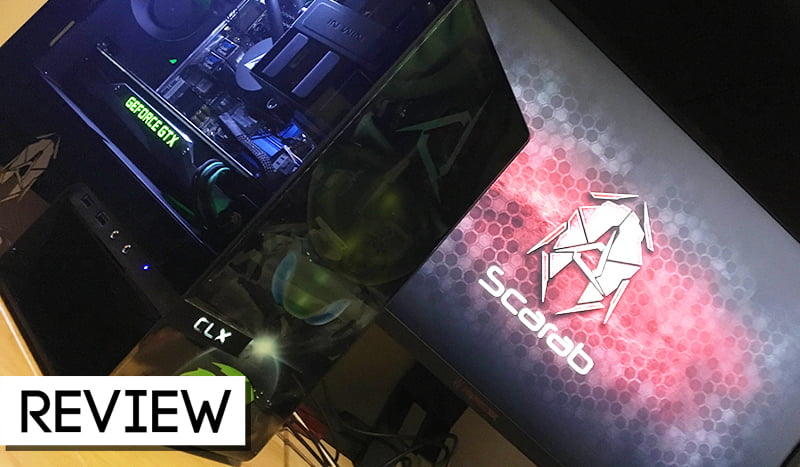

CybertronPC has around since 1997, but its CLX line of custom luxury gaming beast machines are a recent development. Today we look at the line’s small-but-powerful desktop, the Scarab.
Before we begin, let me establish that the Kansas-based computer company has no connection whatsoever to Hasbro’s popular line of transforming robots, who happen to hail from the planet Cybertron. CybertronPC is not allowed to reference the Autobots, Decepticons, Maximals or Predacons in their marketing material. I, on the other hand, can reference them all I want, so I will.
The CLX is a new dedicated luxury gaming line of systems, with names inspired not by the millions of years of conflict between warring factions of transforming robots, but rather by Egyptian mythology. There are three desktops—the small Scarab, the medium Horus and the towering Ra, as well as a pair of laptops, the Anubis and Osiris. Would they have worked better as the Bumblebee, Lazerbeak, Optimus Prime, Ravage and Megatron (tank version)? It hardly matters, as CybertronPC is not affiliated with the Transformers in any way. Also, yes.
The Scarab is the Bumblebee of the lot. It’s small and stylish while still packing a lot of power. Configurations start at $999, which is a price you don’t see very often for a boutique PC. Mind you the $999 is for a system that’s not nearly as pretty as the one I reviewed.
Here’s the base Scarab:
And here’s the CLX Scarab as configured for our review, or as close an approximation as I could generate from the system builder at the official website.
There’s a lot of room to make the smallest CLX system a lot more costly than $999. Custom paint options add a couple hundred to the price. If you’re uncomfortable with overclocking your CPU and GPU yourself, they can do both for an extra $100 or so, with excellent results. They’ve got the Geforce GTX 1080’s 1733MHz clock running at 2075MHz and the 3.40GHz CPU purring at 4.1GHz. At my skill level, had I tried to do that myself I’d have blown something up.
The hardware is tucked neatly away inside CybertronPC’s version of the In Win 901 mini ITX tower case, which is one of the coolest little cases I’ve come across. It’s an aluminium frame with tempered glass side panels that I’d seriously consider picking up for myself if I had a smaller motherboard handy. There are a few odd things about the case, but I’ll cover those once we get a little deeper in.
Combined with the custom paint job from CybertronPC’s in-house team usingHouse of Kolor paint, you wind up with quite an attractive little system.
Of course PC gaming systems are always more than meets the eye. Now that we’ve cracked the shell, let’s crack the nuts inside. One shall stand, one shall fall? Referencing Transformers is tough when the case is screaming Stargate.
What’s Good
Performance: I am beginning to suspect that custom gaming PC builders only send out builds that perform well. I need to start reviewing computers you can pick up at Walmart for a couple hundred bucks.
The Scarab is tiny, but it is a tiny beast, generating frames per second numbers four to seven points better than what I saw in my review of the Geforce GTX 1080 Founders Edition, thanks to a meaty overclock. We’re talking no problems at all with anything at 1920 x 1080, and upwards of 50 FPS at 4K in games like Rise of the Tomb Raider (50 FPS average on highest settings), The Witcher 3 (49) and The Division (51). Metro: Last Light was slightly less of an asshole, allowing for an average of 22 frames per second at 4K (57 at 1920 x 1080), which is pretty outstanding, all things considered.
Silence: At several points during my testing of the Scarab I had to check to see if the radiator fan was spinning. For the most part (see below) it was. I don’t know it it’s the case acoustics or what, but this little system is eerily quiet. My attempts at overclocking the Geforce GTX 1080 on its lonesome always resorted in egregious fan noise. They’ve got it clocked up from 1733MHz to 2075MHz and I am not hearing a thing. It’s kind of scary, really.
Style: Starting with a branded In Win 901 was an excellent choice, the smoky tempered glass adding futuristic elegance to the normal PC parts inside. The black and green cable covers add a nice bit of color to the system’s innards as well.
The glass sides make the Egyptian-themed art on the outside seem much less obnoxious that it would had it covered the entire case. And while others might prefer a solid color or more basic pattern (both are available—they’ll even paint the inside of the case), I’ve enjoyed having such a unique looking box on my desk.
Size: At 13.8″ x 6.8″ x 15.7″, the Scarab isn’t some superslim machine that requires custom-built parts or Tetris-style stacking to make everything fit. It’s a lovingly-assembled box of PC parts that doesn’t take up too much room. Going from the all-in-one PC I recently reviewed to this one wasn’t much of a spatial sacrifice. It’s cute.
What’s Not-So-Good
Case Complications: As much as I love the Scarab’s 901 case, it does make cable handling a bit of a chore. The rear of the unit, where the motherboard ports are located, is recessed and covered with an aluminium plate. While the plate has a cutout for running cables, my large hands don’t quite fit. The plate is easily removable via four speed screws, but it’s also where the CPU cooler’s radiator and fan are mounted, so you can’t move it far.
I first set up the system in my living room, which required installation of a wireless antenna to get a strong signal. Within 20 minutes of gameplay (World of Warcraft, if you must know) the system shut down. I rebooted, played for five minutes, and the system shut down. Feeling a lot of heat from the back of the machine, I checked and realized that the antenna cables were interfering with the radiator fan, causing it to not spin. Removing the posts from the cables fixed it right up, but it’s still pretty cramped in there between the wires and fans. Once everything is in place and you don’t have to worry about plugging and unplugging things it’s fine, but it can be a bit tricky at first.
The Gaming PC Identity
CybertronPC’s been putting together gaming systems for years, reliable machines that have made many PC gamers very happy. They’ve just been kind of all over the place in terms of style. If you looked at one and didn’t see the logo, you might be hard-pressed to guess the brand. The CLX line of customluxury gaming systems focuses the company’s best talent and resources an a series of systems that define their gaming ambitions, systems that are indubitably theirs.
The Scarab starts with a popular mini ITX case, sure, but what makes it different is the paint job, the silent overclocking and the care that went into making this system the lovable Bumblebee of the CLX line. It has the touch. It also has the power.
[Source:-Kotaku]





